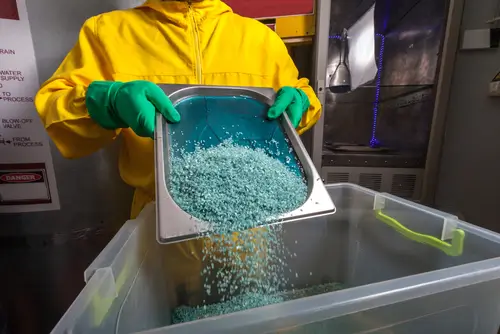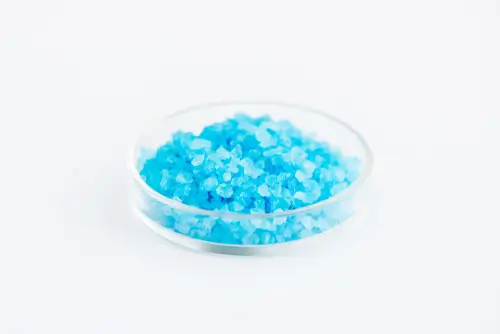Blue meth, known formally as Blue Sky, gets its distinctive color from a chemical reaction during manufacturing. The color comes from copper or cobalt compounds that bind to the meth crystals as catalysts. While blue meth may seem fictional, the science behind how it’s made is quite real.
Some small-scale meth makers produce blue-colored batches, but blue meth is not intrinsically more potent or pure. The color comes down to what ingredients the cook has on hand. Larger operations focus on maximizing yield, not aesthetics, so they rarely produce blue products.
However, because of the myth popularized by Breaking Bad, some dealers or users may believe blue meth has a charisma that allows them to charge a premium.
The DEA has found little evidence that blue meth poses any greater danger. While all meth is unsafe and highly addictive, color alone does not necessarily indicate higher purity or potency. The effects depend on the actual amount and type of methamphetamine present.
Is Blue Meth Real?
While an intriguing concept, the “blue meth” from Breaking Bad is fictional. Outside of a few isolated cases, most meth on the streets looks like any other crystalline powder. The truth is color means little when it comes to this dangerous drug, and the only truth that matters is that all meth, blue or otherwise, should be avoided.

The Origins of Blue Meth in Pop Culture
If you’ve watched Breaking Bad, you’ve heard of blue meth. The show popularized the idea that extremely pure methamphetamine has a bright blue color. But is blue meth just fiction, or does it exist?
The creators of Breaking Bad’s devised the idea of a blue-tinged product to make the meth Walter White produces look distinct. They never intended for it to reflect reality. However, as the show grew in popularity, some real-world drug dealers and makers began manufacturing and marketing blue-colored meth to capitalize on the show’s success.
Some “Heisenberg” wannabes use food coloring or dye to make their meth blue. Others claim that certain production methods can lead to a faint blue tint. But according to experts, pure meth made from pseudoephedrine and anhydrous ammonia—as in Breaking Bad—would not turn blue. The blue color is a myth.
While most blue meth is colored for effect, a small portion could be tainted or cut with chemicals that impart a blue shade. Of course, this makes the product more toxic and dangerous. Bottom line: whether blue or not, street meth is extremely dangerous and it’s best to avoid them altogether. Your life is worth far more than chasing a fantasy high.
Learn more: Meth Rehab In Los Angeles

Is Blue Meth More Potent or Pure? Debunking the Myth
The idea that blue meth is more potent or pure is a myth. The blue color comes from an impurity introduced during manufacturing, not the methamphetamine itself. While some claim it comes from a special ingredient that increases potency, the blue tint comes from a chemical reaction between red phosphorus and iodine components used during one of the steps used to produce the drug.
The distinctive blue color has been used primarily as a marketing tactic to differentiate the product and make it appear high quality. However, the color has no bearing on the potency, purity, or quality of the meth. Street meth of any color can vary wildly in purity, from less than 20% to over 95% methamphetamine.
How Blue Meth Is Made and Why It’s Colored Blue
Manufacturers create blue meth through chemical processes that alter the color of regular crystal meth. Some mix in blue dye or chalk to make it appear purer, but others use more complex methods to change the chemical composition.
Mixing in Dye or Chalk
The easiest way to make meth blue is by crushing blue chalk or dye and mixing it with finished crystal meth. This is mainly done for appearance and does not affect the potency or purity. It’s mostly used as a marketing tactic.
Using Battery Acid or Ammonia
More sophisticated cooks use a chemical reduction process with battery acid or ammonia to alter the pseudoephedrine or ephedrine. This multi-step reaction combines phenylacetone (P2P) and methylamine to yield a purer form of meth that also gets around restrictions on pseudoephedrine products. The result is a powder with a light blue tint due to the chemicals used.
Some key signs that meth may have been made using this method include:
- A faint chemical smell of ammonia or acetone
- A slightly coarse, grainy texture
- Respiratory irritation from inhaling the vapors
While purer, blue meth made this way is extremely dangerous and toxic. The risks of overdose and long-term health effects are severe.

The Dangers of Meth Use: Blue or Otherwise
The dangers of methamphetamine use are very real, whether it’s blue meth or any other form of this illegal and highly addictive stimulant. Here are some of the major health risks associated with meth use:
Physical Effects
- Irregular heartbeat and increased risk of heart attack or stroke: Meth constricts blood vessels and increases blood pressure, putting strain on the heart.
- Difficulty sleeping and eating: Meth suppresses appetite and causes insomnia, leading to malnutrition and exhaustion.
- “Tweaking,” which includes irritability, anxiety, and psychotic behavior: Meth causes dopamine overload in the brain, inducing temporary psychosis and paranoia.
Brain and Organ Damage
- Memory loss and impaired cognitive abilities: Meth destroys dopamine receptors and causes structural changes in the brain that can lead to permanent mental impairment.
- Liver, kidney, and lung disease: The chemicals used to make meth are toxic and damage major organs.
- Dental problems include tooth decay, loss, and meth mouth: Meth causes dry mouth and teeth grinding, and users often neglect oral hygiene.
Mental Health Issues
- Depression and suicidal thoughts: The dopamine crash after the high leads to anhedonia—the inability to feel pleasure—and deep depression.
- Psychosis, delusions, and hallucinations: Long-term meth use frequently causes a break from reality, and in some cases, the psychosis becomes permanent.
- Anxiety, agitation, and paranoia: Meth induces a constant state of “fight or flight,” even when no real threats exist. This takes a major psychological toll.
While the idea of blue meth may seem glamorous in fiction, the truth is that all forms of methamphetamine are extraordinarily dangerous and addictive. No high is worth risking your health, relationships, and sanity over. Many treatment options and support groups are available for those struggling with meth addiction.
Read more: What Does Meth Do To Someone Who Has ADHD?
Contact Launch Centers in Los Angeles
If you or someone you know is struggling with meth addiction and want to learn more about addiction treatment, contact Launch Centers. Our treatment team has years of experience with various substance use and mental health disorders, specifically incorporating holistic and trauma-informed therapy methods to address underlying factors and triggers. Call today, and our admissions team can fill you in on what goes on at our center and how we can help.





